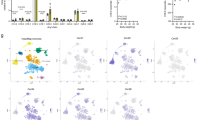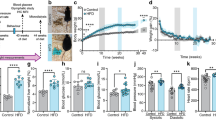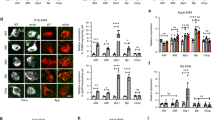Abstract
Background:
Consumption of dietary fat is one of the key factors leading to obesity. High-fat diet (HFD)-induced obesity is characterized by induction of inflammation in the hypothalamus; however, the temporal regulation of proinflammatory markers and their impact on hypothalamic appetite-regulating neuropeptide Y/agouti-related peptide (NPY/AgRP) neurons remains undefined.
Methods:
Mice were injected with an acute lipid infusion for 24 h or fed a HFD over 8–20 weeks. Characterized mouse NPY/AgRP hypothalamic cell lines were used for in vitro experimentation. Immunohistochemistry in brain slices or quantitative real-time PCR in cell lines, was performed to determine changes in the expression of key inflammatory markers and neuropeptides.
Results:
Hypothalamic inflammation, indicated by tumor necrosis factor (TNF)-α expression and astrocytosis in the arcuate nucleus, was evident following acute lipid infusion. HFD for 8 weeks suppressed TNF-α, while significantly increasing heat-shock protein 70 and ciliary neurotrophic factor, both neuroprotective components. HFD for 20 weeks induced TNF-α expression in NPY/AgRP neurons, suggesting a detrimental temporal regulatory mechanism. Using NPY/AgRP hypothalamic cell lines, we found that palmitate provoked a mixed inflammatory response on a panel of inflammatory and endoplasmic reticulum (ER) stress genes, whereas TNF-α significantly upregulated IκBα, nuclear factor (NF)-κB and interleukin-6 mRNA levels. Palmitate and TNF-α exposure predominantly induced NPY mRNA levels. Utilizing an I kappa B kinase β (IKKβ) inhibitor, we demonstrated that these effects potentially occur via the inflammatory IKKβ/NF-κB pathway.
Conclusions:
These findings indicate that acute lipid and chronic HFD feeding in vivo, as well as acute palmitate and TNF-α exposure in vitro, induce markers of inflammation or ER stress in the hypothalamic appetite-stimulating NPY/AgRP neurons over time, which may contribute to a dramatic alteration in NPY/AgRP content or expression. Acute and chronic HFD feeding in vivo temporally regulates arcuate TNF-α expression with reactive astrocytosis, which suggests a time-dependent neurotrophic or neurotoxic role of lipids.
This is a preview of subscription content, access via your institution
Access options
Subscribe to this journal
Receive 12 print issues and online access
$259.00 per year
only $21.58 per issue
Buy this article
- Purchase on Springer Link
- Instant access to full article PDF
Prices may be subject to local taxes which are calculated during checkout






Similar content being viewed by others
References
Flier JS . Obesity wars: molecular progress confronts an expanding epidemic. Cell 2004; 116: 337–350.
Niswender KD, Morton GJ, Stearns WH, Rhodes CJ, Myers Jr MG, Schwartz MW . Intracellular signalling. Key enzyme in leptin-induced anorexia. Nature 2001; 413: 794–795.
Milanski M, Degasperi G, Coope A, Morari J, Denis R, Cintra DE et al. Saturated fatty acids produce an inflammatory response predominantly through the activation of TLR4 signaling in hypothalamus: implications for the pathogenesis of obesity. J Neurosci 2009; 29: 359–370.
De Souza CT, Araujo EP, Bordin S, Ashimine R, Zollner RL, Boschero AC et al. Consumption of a fat-rich diet activates a proinflammatory response and induces insulin resistance in the hypothalamus. Endocrinology 2005; 146: 4192–4199.
Howard JK, Cave BJ, Oksanen LJ, Tzameli I, Bjorbaek C, Flier JS . Enhanced leptin sensitivity and attenuation of diet-induced obesity in mice with haploinsufficiency of Socs3. Nat Med 2004; 10: 734–738.
Lemus MB, Bayliss JA, Lockie SH, Santos VV, Reichenbach A, Stark R et al. A stereological analysis of NPY, POMC, Orexin, GFAP astrocyte, and Iba1 microglia cell number and volume in diet-induced obese male mice. Endocrinology 2015; 156: 1701–1713.
Wang H, Storlien LH, Huang XF . Effects of dietary fat types on body fatness, leptin, and ARC leptin receptor, NPY, and AgRP mRNA expression. Am J Physiol Endocrinol Metab 2002; 282: E1352–E1359.
Alkemade A, Yi CX, Pei L, Harakalova M, Swaab DF, la Fleur SE et al. AgRP and NPY expression in the human hypothalamic infundibular nucleus correlate with body mass index, whereas changes in alphaMSH are related to type 2 diabetes. J Clin Endocrinol Metab 2012; 97: E925–E933.
Akira S, Takeda K . Toll-like receptor signalling. Nat Rev Immunol 2004; 4: 499–511.
Hayden MS, Ghosh S . Shared principles in NF-kappaB signaling. Cell 2008; 132: 344–362.
Miyazaki Y, Pipek R, Mandarino LJ, DeFronzo RA . Tumor necrosis factor alpha and insulin resistance in obese type 2 diabetic patients. Int J Obes Relat Metab Disord 2003; 27: 88–94.
Thaler JP, Yi CX, Schur EA, Guyenet SJ, Hwang BH, Dietrich MO et al. Obesity is associated with hypothalamic injury in rodents and humans. J Clin Invest 2012; 122: 153–162.
Amaral ME, Barbuio R, Milanski M, Romanatto T, Barbosa HC, Nadruz W et al. Tumor necrosis factor-alpha activates signal transduction in hypothalamus and modulates the expression of pro-inflammatory proteins and orexigenic/anorexigenic neurotransmitters. J Neurochem 2006; 98: 203–212.
Cansell C, Castel J, Denis RG, Rouch C, Delbes AS, Martinez S et al. Dietary triglycerides act on mesolimbic structures to regulate the rewarding and motivational aspects of feeding. Mol Psychiatry 2014; 19: 1095–1105.
Dalvi PS, Nazarians-Armavil A, Purser MJ, Belsham DD . Glucagon-like peptide-1 receptor agonist, exendin-4, regulates feeding-associated neuropeptides in hypothalamic neurons in vivo and in vitro. Endocrinology 2012; 153: 2208–2222.
Belsham DD, Cai F, Cui H, Smukler SR, Salapatek AM, Shkreta L . Generation of a phenotypic array of hypothalamic neuronal cell models to study complex neuroendocrine disorders. Endocrinology 2004; 145: 393–400.
Belsham DD, Fick LJ, Dalvi PS, Centeno ML, Chalmers JA, Lee PK et al. Ciliary neurotrophic factor recruitment of glucagon-like peptide-1 mediates neurogenesis, allowing immortalization of adult murine hypothalamic neurons. FASEB J 2009; 23: 4256–4265.
Dhillon SS, McFadden SA, Chalmers JA, Centeno ML, Kim GL, Belsham DD . Cellular leptin resistance impairs the leptin-mediated suppression of neuropeptide Y secretion in hypothalamic neurons. Endocrinology 2011; 152: 4138–4147.
Hamilton JA, Johnson RA, Corkey B, Kamp F . Fatty acid transport: the diffusion mechanism in model and biological membranes. J Mol Neurosci 2001; 16: 99–108 discussion 151–157.
Sofroniew MV . Molecular dissection of reactive astrogliosis and glial scar formation. Trends Neurosci 2009; 32: 638–647.
Ransohoff RM, Perry VH . Microglial physiology: unique stimuli, specialized responses. Annu Rev Immunol 2009; 27: 119–145.
Sofroniew MV, Vinters HV . Astrocytes: biology and pathology. Acta Neuropathol 2010; 119: 7–35.
Zhang X, Zhang G, Zhang H, Karin M, Bai H, Cai D . Hypothalamic IKKbeta/NF-kappaB and ER stress link overnutrition to energy imbalance and obesity. Cell 2008; 135: 61–73.
Cheng B, Christakos S, Mattson MP . Tumor necrosis factors protect neurons against metabolic-excitotoxic insults and promote maintenance of calcium homeostasis. Neuron 1994; 12: 139–153.
Marchetti L, Klein M, Schlett K, Pfizenmaier K, Eisel UL . Tumor necrosis factor (TNF)-mediated neuroprotection against glutamate-induced excitotoxicity is enhanced by N-methyl-D-aspartate receptor activation. Essential role of a TNF receptor 2-mediated phosphatidylinositol 3-kinase-dependent NF-kappa B pathway. J Biol Chem 2004; 279: 32869–32881.
Bruce AJ, Boling W, Kindy MS, Peschon J, Kraemer PJ, Carpenter MK et al. Altered neuronal and microglial responses to excitotoxic and ischemic brain injury in mice lacking TNF receptors. Nat Med 1996; 2: 788–794.
Turturici G, Sconzo G, Geraci F . Hsp70 and its molecular role in nervous system diseases. Biochem Res Int 2011; 2011: 618127.
Kokoeva MV, Yin H, Flier JS . Neurogenesis in the hypothalamus of adult mice: potential role in energy balance. Science 2005; 310: 679–683.
Gropp E, Shanabrough M, Borok E, Xu AW, Janoschek R, Buch T et al. Agouti-related peptide-expressing neurons are mandatory for feeding. Nat Neurosci 2005; 8: 1289–1291.
Picardi PK, Caricilli AM, de Abreu LL, Carvalheira JB, Velloso LA, Saad MJ . Modulation of hypothalamic PTP1B in the TNF-alpha-induced insulin and leptin resistance. FEBS Lett 2010; 584: 3179–3184.
Holland WL, Bikman BT, Wang LP, Yuguang G, Sargent KM, Bulchand S et al. Lipid-induced insulin resistance mediated by the proinflammatory receptor TLR4 requires saturated fatty acid-induced ceramide biosynthesis in mice. J Clin Invest 2011; 121: 1858–1870.
Benoit SC, Kemp CJ, Elias CF, Abplanalp W, Herman JP, Migrenne S et al. Palmitic acid mediates hypothalamic insulin resistance by altering PKC-theta subcellular localization in rodents. J Clin Invest 2009; 119: 2577–2589.
Dougherty RM, Fong AK, Iacono JM . Nutrient content of the diet when the fat is reduced. Am J Clin Nutr 1988; 48: 970–979.
Gao Y, Han C, Huang H, Xin Y, Xu Y, Luo L et al. Heat shock protein 70 together with its co-chaperone CHIP inhibits TNF-alpha induced apoptosis by promoting proteasomal degradation of apoptosis signal-regulating kinase1. Apoptosis 2010; 15: 822–833.
Sharp FR, Massa SM, Swanson RA . Heat-shock protein protection. Trends Neurosci 1999; 22: 97–99.
Sendtner M, Carroll P, Holtmann B, Hughes RA, Thoenen H . Ciliary neurotrophic factor. J Neurobiol 1994; 25: 1436–1453.
Sleeman MW, Anderson KD, Lambert PD, Yancopoulos GD, Wiegand SJ . The ciliary neurotrophic factor and its receptor, CNTFR alpha. Pharm Acta Helv 2000; 74: 265–272.
Severi I, Perugini J, Mondini E, Smorlesi A, Frontini A, Cinti S et al. Opposite effects of a high-fat diet and calorie restriction on ciliary neurotrophic factor signaling in the mouse hypothalamus. Front Neurosci 2013; 7: 263.
Gloaguen I, Costa P, Demartis A, Lazzaro D, Di Marco A, Graziani R et al. Ciliary neurotrophic factor corrects obesity and diabetes associated with leptin deficiency and resistance. Proc Natl Acad Sci USA 1997; 94: 6456–6461.
Lambert PD, Anderson KD, Sleeman MW, Wong V, Tan J, Hijarunguru A et al. Ciliary neurotrophic factor activates leptin-like pathways and reduces body fat, without cachexia or rebound weight gain, even in leptin-resistant obesity. Proc Natl Acad Sci USA 2001; 98: 4652–4657.
Bluher S, Moschos S, Bullen Jr J, Kokkotou E, Maratos-Flier E, Wiegand SJ et al. Ciliary neurotrophic factorAx15 alters energy homeostasis, decreases body weight, and improves metabolic control in diet-induced obese and UCP1-DTA mice. Diabetes 2004; 53: 2787–2796.
Chandrasekharan B, Jeppsson S, Pienkowski S, Belsham DD, Sitaraman SV, Merlin D et al. Tumor necrosis factor (TNF)-neuropeptide Y (NPY) crosstalk regulates inflammation, epithelial barrier functions and colonic motility. Inflamm Bowel Dis 2013; 19: 2535–2546.
Won JC, Jang PG, Namkoong C, Koh EH, Kim SK, Park JY et al. Central administration of an endoplasmic reticulum stress inducer inhibits the anorexigenic effects of leptin and insulin. Obesity (Silver Spring) 2009; 17: 1861–1865.
Mayer CM, Belsham DD . Palmitate attenuates insulin signaling and induces endoplasmic reticulum stress and apoptosis in hypothalamic neurons: rescue of resistance and apoptosis through adenosine 5' monophosphate-activated protein kinase activation. Endocrinology 2010; 151: 576–585.
Moraes JC, Coope A, Morari J, Cintra DE, Roman EA, Pauli JR et al. High-fat diet induces apoptosis of hypothalamic neurons. PLoS One 2009; 4: e5045.
Acknowledgements
We thank the Canadian Institutes for Health Research (CIHR) (DDB, MBW), Canadian Diabetes Association (DDB, MBW) and Canada Research Chairs Program (DDB) for funding this study. Scholarship support through the Banting and Best Diabetes Research Centre (to PSD, LW), CIHR Fellowship (to LW), NSERC Studentships (to PSD and DQT), and an Ontario Graduate Scholarship (to PSD and DQT) is much appreciated.
Author information
Authors and Affiliations
Corresponding author
Ethics declarations
Competing interests
The authors declare no conflict of interest.
Additional information
Supplementary Information accompanies this paper on International Journal of Obesity website
Supplementary information
Rights and permissions
About this article
Cite this article
Dalvi, P., Chalmers, J., Luo, V. et al. High fat induces acute and chronic inflammation in the hypothalamus: effect of high-fat diet, palmitate and TNF-α on appetite-regulating NPY neurons. Int J Obes 41, 149–158 (2017). https://doi.org/10.1038/ijo.2016.183
Received:
Revised:
Accepted:
Published:
Issue Date:
DOI: https://doi.org/10.1038/ijo.2016.183
This article is cited by
-
Inflammatory Milieu Induces Mitochondrial Alterations and Neuronal Activations in Hypothalamic POMC Neurons in a Time-Dependent Manner
Molecular Neurobiology (2023)
-
High-Fat Diet Exacerbates Autistic-Like Restricted Repetitive Behaviors and Social Abnormalities in CC2D1A Conditional Knockout Mice
Molecular Neurobiology (2023)
-
Adamantinomatous craniopharyngioma cyst fluid can trigger inflammatory activation of microglia to damage the hypothalamic neurons by inducing the production of β-amyloid
Journal of Neuroinflammation (2022)
-
Deficiency of exchange protein directly activated by cAMP (EPAC)-1 in mice augments glucose intolerance, inflammation, and gut dysbiosis associated with Western diet
Microbiome (2022)
-
Hydrogen Sulfide Attenuates High-Fat Diet-Induced Obesity: Involvement of mTOR/IKK/NF-κB Signaling Pathway
Molecular Neurobiology (2022)



